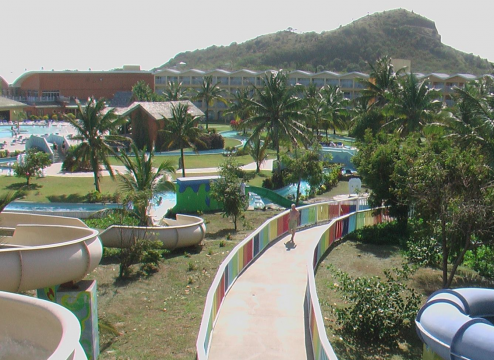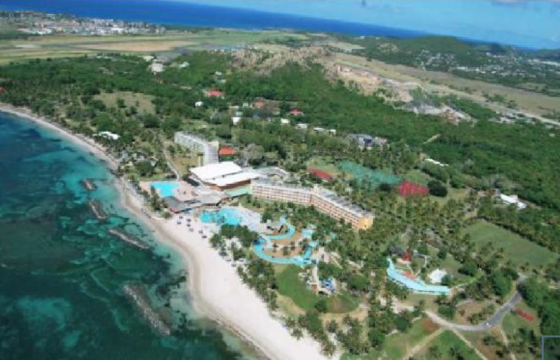Construction of rainwater harvesting and waste water recycling facility at the Coconut Bay Beach Resort and Spa, Vieux Fort, St. Lucia.


View of a section of the CBBRAS water park. Photograph courtesy of Winston Bennett
Background
The Special Program for Adaptation to Climate Change (SPACC) pilot project “To complement the national water supply programme by establishing adaptation measures that would result in increased resilience of surrounding coastal ecosystems to the impacts of climate change” was implemented in St. Lucia by the World Bank, acting as the implementing agency for the Global Environment Facility (GEF), and the Caribbean Community Climate Change Centre (CCCCC), acting as the executing agency.
St. Lucia’s experiences
Climate models project changes in total and distribution of rainfall over time and space. The climate will display more intense and extreme events, both storms and droughts. Data and information collected during Hurricane Tomas in Saint Lucia in 2010 revealed that up to 25 inches of rainfall fell in some areas during a 24 hour period.
However, rainfall is projected to decrease overall for the Southern Caribbean, with an anticipated 26-53% decrease in precipitation by 2050. Fewer heavy rainfall events are expected. More intense dry spells are also predicted. During the dry season of 2009 and 2010 St. Lucia experienced the worst drought in the last 40 year period
An average of three to four Category 4 and 5 hurricanes per year is expected by the year 2025 in the Atlantic Basin.

Coastal location of report
Lessons learned and recommendations
Both rainwater tanks were relocated by a few meters from the locations originally planned, to avoid damage to utilities within the planned footprint. There was no negative impact on the existing utilities in the new locations. There was no cost implication associated with the relocations since the decisions were made before construction started.
A decision had to be made about the use of the harvested rain-water. The original plan was to use this water for the flushing toilets throughout the establishment. However it was discovered that significant noise and dust would be generated from the requirement to break through the hotel’s floors and walls in order to make the connection inside the utility shafts, a situation that was unacceptable to CBBRAS’ management in light of the attendant likely operational disruptions. Also, after concerted effort on the part of the Contractor and the Supervisor to locate suitable fittings (at an acceptable cost) required for the plumbing connections between the new rainwater harvesting system and the existing, aged French copper toilet plumbing fittings and the risk to other existing, aged infrastructure in the utility closets, it was further decided that the proposal to connect to existing toilets was not feasible. An alternate arrangement was to connect this source of water to the pool pump systems instead, to be applied to pool topping up and backwashing, as water demand in the water park is very high.
After the construction of the north rain water storage tank was completed, recommendations were made to increase the volume of the south tank. The capacity was increased by 50%, from 18 014 L (3 962 Imp gal) to 27 020 L (5 944 Imp gal).
There had been no provision for meters in the original design. During the implementation of the project it was proposed, and accepted, that meters should be placed on all pump outlets, to facilitate monitoring of the system performance and evaluating the benefits. CBBRAS also undertook to install a meter on the outlet of the existing water storage tank that receives pipe- borne and tanker- truck delivered water.
The wastewater effluent tank was painted on the outside and, although not a part of the original design and plan, a mesh cover was installed to discourage mosquito breeding and prevent decaying plant material from collecting inside.
The foregoing variations were discussed and agreed upon during a World Bank/CCCCC mission, and were typically reflected through amendment of quantities in the existing Bill of Quantities, to which existing bill rates were applied.
Rainwater plumbing to move water from the roofs of the wings closest to the hotel central structure had to be re-routed around the elevator shafts at the first floor level (for aesthetics) and then underground, to the storage tanks at either end of the building.
The success of this project demonstrated the results of public-private partnerships. Similar opportunities for such partnerships might be should be sought after in order to achieve similar meaningful results.
The outputs of the SPACC Project need to be realized, mainstreamed and diffused at the earliest possibility, and extended to other sectors, other infrastructure, and other Caribbean countries.
(0) Comments
There is no content